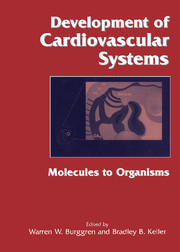Book contents
- Frontmatter
- Contents
- List of contributors
- Foreword by Constance Weinstein
- Introduction: Why study cardiovascular development?
- Part I Molecular, cellular, and integrative mechanisms determining cardiovascular development
- Part II Species diversity in cardiovascular development
- 9 Evolution of cardiovascular systems: Insights into ontogeny
- 10 Morphogenesis of vertebrate hearts
- 11 Invertebrate cardiovascular development
- 12 Piscine cardiovascular development
- 13 Amphibian cardiovascular development
- 14 Reptilian cardiovascular development
- 15 Avian cardiovascular development
- 16 Mammalian cardiovascular development: Physiology and functional reserve of the fetal heart
- Part III Environment and disease in cardiovascular development
- Epilogue: Future directions in developmental cardiovascular sciences
- References
- Systematic index
- Subject index
10 - Morphogenesis of vertebrate hearts
from Part II - Species diversity in cardiovascular development
Published online by Cambridge University Press: 10 May 2010
- Frontmatter
- Contents
- List of contributors
- Foreword by Constance Weinstein
- Introduction: Why study cardiovascular development?
- Part I Molecular, cellular, and integrative mechanisms determining cardiovascular development
- Part II Species diversity in cardiovascular development
- 9 Evolution of cardiovascular systems: Insights into ontogeny
- 10 Morphogenesis of vertebrate hearts
- 11 Invertebrate cardiovascular development
- 12 Piscine cardiovascular development
- 13 Amphibian cardiovascular development
- 14 Reptilian cardiovascular development
- 15 Avian cardiovascular development
- 16 Mammalian cardiovascular development: Physiology and functional reserve of the fetal heart
- Part III Environment and disease in cardiovascular development
- Epilogue: Future directions in developmental cardiovascular sciences
- References
- Systematic index
- Subject index
Summary
The origin of the heart and early morphogenesis
The origin of the heart has been classically studied in the developing embryo by producing prospective maps of the early blastoderm (DeHaan, 1965; Rosenquist & DeHaan, 1966). Recently, fate mapping has traced the origin of the heart back to the primitive-streak stages (Garcia-Martinez & Schoenwolf, 1993). Precardiac cells ingress through the primitive streak and migrate toward the anterior embryonic pole to form a loose but cohesive epithelial sheet. Then, precardiac cells condense in crescent-shaped areas of the splanchnic mesoderm. The formation of the precardiac mesoderm is the first morphological indication of the heart anlage. The anlage is formed of premyocardial cells, preendocardial cells, and associated extracellular material (Figure 10.1). Later fusion of the paired primordium under the endodermal foregut results in formation of the primitive tubular heart (Figures 10.1-10.2). This process has been reviewed in Manasek et al., 1986; Icardo, 1988; and Icardo, Fernandez-Teran, and Ojeda, 1990.
The mechanisms that regulate condensation of the precardiac cells to form the cardiogenic crescent are poorly understood. The use of cell adhesion molecules (CAMs) has provided some information on this matter. N-cadherin, a calcium-dependent CAM that shows an even distribution on the surface of the early mesodermal cells, changes to an apical localization as the mesoderm splits into the parietal and splanchnic layers, the pericardial coelom forms, and mesodermal cells condense into the cardiogenic crescent (Linask, 1992). Similarly, integrin (a cell surface receptor for fibronectin) redistributes to a basal localization, and Na+, K+- ATPase activity becomes restricted to the lateral surfaces of the premyocytes (Linask, 1992).
- Type
- Chapter
- Information
- Development of Cardiovascular SystemsMolecules to Organisms, pp. 114 - 126Publisher: Cambridge University PressPrint publication year: 1998



